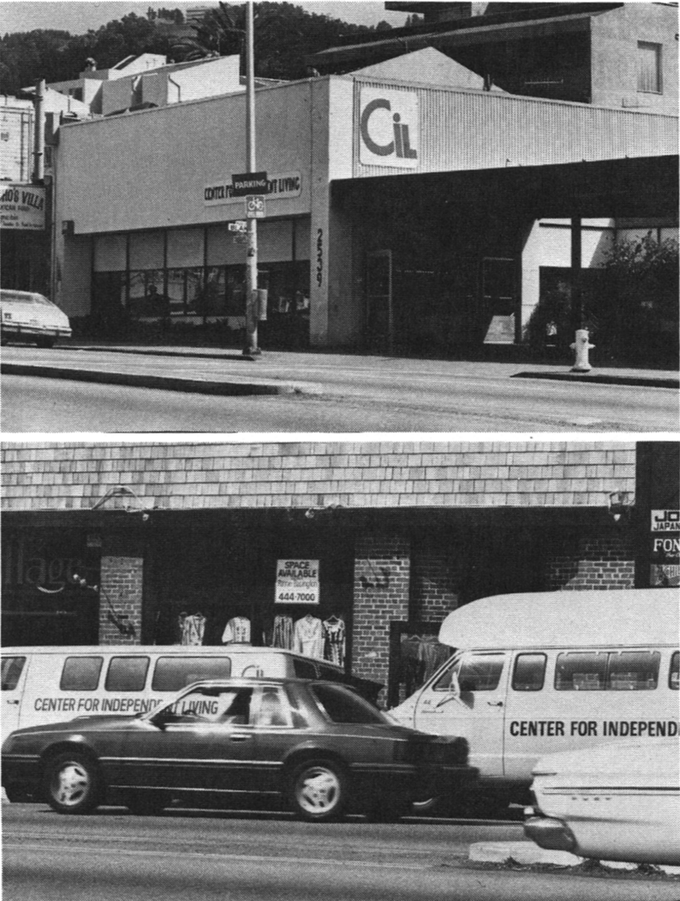Life Styles#
The Berkeley Crips#
I always knew they were crazy in Berkeley. When I was a kid, the crazy rock climbers all came from Berkeley, and then the political activists. Now the crazy wheelers are all there.
For example, Berkeley has curb cuts everywhere. There is no place on Earth with more curb cuts per capita than Berkeley. The only place they don’t have curb cuts is at street corners. Instead, they put the cuts about 30 feet away from the stop sign or crosswalk, clearly an attempt on the part of the city fathers to eliminate all wheelers by forcing them to J-walk in moving traffic. That, to me, is really crazy.
I asked a local quad why they did a dumb thing like that. Well, schmuck, the reason is that blind people need the curbs to define the corners and establish direction. Ramps have very little to say to a white cane.
A little later, I saw two blind women approaching the restaurant on Telegraph Avenue where I was eating. They arrived from different directions, reached the door within microseconds of each other, greeted affectionately, entered, ordered at the counter and easily found their own way to an empty table because the cashier had given them clear instructions. I saw a quad order coffee. He didn’t ask for a straw, but he was given one in case he wanted it. It’s like that in Berkeley — people there act as if they’ve been trained in multi-disability rehab centers. There’s an awareness of all disabilities and tunnel vision viewpoints such as my own indignation over the curb cuts are not admired.
Actually, no place is that good through and through. But Berkeley, for a disabled person, is very good. This is radical-land, as it has been for years, but the gimps are the most visible rabble rousers in town. They’ve created a seething crucible of heavy duty disability politics, and are together, effective and militant. They hold sit-ins (what else?), they demonstrate, they bring suit. They also create some backlash from wheelers (see Mary Wilson) and the community (they’re called CILLIES, after CIL, the Center for Independent Living), but they have made Berkeley a Mecca for anyone who is disabled. “Disabled” is a word that seems to see light only in print and in speeches here. The preferred and operative word is CRIP. If it bothers you, don’t go to Berkeley. Berkeley is the way it is, for its crips, largely because of the Berkeley Center for Independent Living.
The Berkeley CIL#
For a place that deals with the mobility-impaired, not to mention dozens of other disabilities, CIL is extremely speedy. Outside, vans are constantly arriving and departing. Inside, they’re organizing for a protest at BART. Electric chairs avoid collision by microns as their owners zip purposefully around blind corners. Lots of sign language going on. It’s a happy, crazy place.
My wheelchair and T12 lesion are no badge of membership here because, by prevailing standards, I’ve barely sustained a scratch. The variety and severity of disabilities is overwhelming, enlightening and radicalizing. It tends to abruptly pop you out of your SCI rut. There’s a lot of other things that can happen to you.
CIL was started in 1972 by disabled people who wanted to integrate themselves and their own into the community. The idea was to get out of institutions or family basements and into homes and jobs. It is, by definition, a community-based nonresidential program. Nobody lives there, and the Center opposes “cripple ghettos,” live-in segregated housing. They want genuine integration and genuine independence. The following partial list of services suggests how they achieve their ends.
Attendant referral
Housing referral
Transportation
Home modification
Emergency road service
Peer counseling
Outreach programs
Wheelchair repair shop
Wheelchair design project
Advocacy
Legal interpretation
Benefits counseling
Disability Law Resources Center
Anti-discrimination help
DVR liaison (Ombudsman Program)
Job development
Job placement
Training and education
Computer training program
Their funding comes from federal, state and city grants, plus increasingly large participation from the private sector in the form of dollars, training and jobs. It’s an extremely broad coalition because services are provided for all physical disabilities (and some which are not physical), because CIL cooperates closely, often under contract, with government agencies and businesses and because the support of the community-at-large has been successfully enlisted.
Independent Living Programs#
While the Berkeley CIL is the first and largest, it is far from being the only organization of its kind. It is now one of over 100 across the nation. If you’re feeling long on disability and short on resources, and you want to live independently in your community, it may behoove you to contact the nearest Independent Living Program. It could change your life—in your work, in your contacts with the rest of the world and in the way you live. A list of these programs and centers can be found in the NSCIF National Resource Directory of 1979. Updated lists will presumably be found in subsequent issues of this excellent directory. For some people, independent living programs are the hottest of hot tips.

